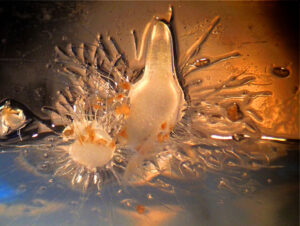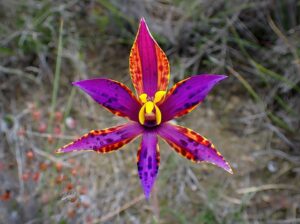Saving the Queen of Sheba, a conservation success story
By Dan Austin
As one of the most biodiverse locations on the planet, the South Western Australian Floristic Region draws in plant enthusiasts from across the nation, and the world, for a chance to glimpse something special from the area’s extraordinary botanical palette.
Western Australia has a widely known reputation for having some of the most beautiful wildflowers anywhere and illustrating just how hyper-diverse the area is, new species are continually being discovered. Described species have risen by ten percent in the last few decades and over fifty percent of Western Australia’s described flora has been documented in only the last fifty years. You can guarantee you’ll see something amazing when visiting this part of the world at the right time. However, of all the blooms on offer in the Western Australian landscape, there is one that presents unrivalled charisma. The Queen of Sheba orchid (Thelymitra variegata), is a plant whose flamboyant flowers, combining bright yellows, purples and reds, have allowed it to become a poster child for plant conservation.
There are actually several Thelymitra species occurring across Western Australia. Superficially similar, all are protected as they are at severe risk from land clearance, and more recently, careless trampling and poaching. At Perth’s Kings Park and Botanic Garden, researchers have been working to remedy this situation and after years of limited success raising the Queen of Sheba at the garden, a recent breakthrough suggests that the future of this iconic orchid is suddenly looking brighter.

One of the key reasons propagating the Queen of Sheba orchid has posed such a challenge is, like many orchids, the plant’s seeds are minute. The seeds of many orchids are so small they lack sufficient energy stores to germinate alone. Instead, species like the Queen of Sheba have evolved an ingenious relationship with beneficial mycorrhizal fungi, which, upon coming into contact with seed, unite and provide a much-needed boost in resources to fuel the germination of the seed. Later in life, having moved on from such a precarious stage of development, the plants can return the favour in the form of sugars and energy produced through photosynthesis, which the mycorrhizal fungi could not produce alone.
While many beneficial mycorrhizal fungi are known to form mutually beneficial associations with several species of plants, and are somewhat indiscriminate in their relationships, others are highly specialised and exclusive between plant and fungi species. This is the case for the mycorrhizal fungi associated with the Queen of Sheba. The plants in the Kings Park Queen of Sheba research project, led by Dr Belinda Davis, were propagated from seed collected near Albany and Bunbury. Quite a feat given the rarity of the species but sourcing the correct mycorrhizal fungi to assist in the seeds’ germination posed even more of a challenge.
After periods of limited germination, disappointment and determination, the researchers of Kings Park were able to extract the symbiotic fungus from the roots of a wild Queen of Sheba plant and subsequently foster the fungus under lab conditions. Curiously, even with the correct fungi in hand, adding orchid seeds to petri dishes rich in the mycorrhizae, continued to produce limited success. That was until a recent breakthrough changed things forever. It came when researchers were able to determine the nutritional requirements of the fungus for the first time, ensuring its optimum health and the survival of the orchids in laboratory conditions. In the months since, Kings Park staff have been able to propagate Queen of Sheba seedlings in their hundreds!
The success of this technique can also be seen in a growing collection at the Royal Botanic Gardens Victoria where the plants will be used as seed orchids and the eventual introduction of plants back into the wild. It is also thought the findings will contribute to the conservation of species far beyond the Queen of Sheba.
Who knows, maybe this plant will become commercially available one day and finally put an end to senseless poaching of the species.
Whatever the long-term future of the Queen of Sheba orchids, it has become a little brighter thanks to the perseverance of some great botanical minds at our botanic gardens, and funding falling in the right place.
Dan Austin
IPPS Member, Author
Lecturer, TAFE South Australia
M: 049 122 8591
E: daniel.austin@outlook.com
FB: BeyondGreenAustralia
W: ipps.org

